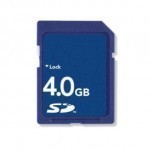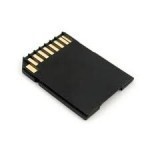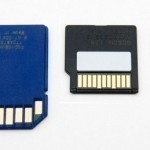NAND drives are high-capacity, high-speed, solid-state flash memory drives. Thanks to new advances in technology, these drives have been chosen to become the latest drive preference for laptop computers (hopefully in the near future). When comparing the NAND to other types of flash memory, NAND drives have several noteworthy advantages. The term "NAND" refers to the architecture of the chip which differs it from NOR (NOT OR) flash memory. NOR flash memory is most widely used in devices in which small programs are executed in place rather than written to Read More
Flash Memory
Flash memory is memory which retains its contents even after power is removed. Flash memory is a form of EAPROM (Electrically Alterable Programmable Read-Only Memory). Each bit of data in a flash memory device is stored in a transistor called a floating gate. The floating gate can only be accessed though another transistor, the control gate. The process the control gate uses to access the floating gate is a field emission phenomenon known as Fowler-Nordheim tunneling. Tunneling allows voltage to flow from the control gate to the floating gate through Read More
What is a Memory Card Reader?
A memory card reader is a device that acts as a connection between a flash memory stick or SD memory card and the computer. In other words, it is a memory hub that makes it possible to connect multiple memory cards to the computer at one time. Once the memory card is attached to the reader and the computer, the user can easily transfer files to and from the reader. Another reason that a memory card reader is beneficial is because it offers different size memory slots. Since there are Read More
Memory Stick

A Memory Stick is an IC (Integrated Circuit) which is stored in a compact and rugged plastic enclosure. Memory Sticks are designed to store data and to enable the transfer of data between devices equipped with Memory Stick slots. Normally, Memory Sticks are used as storage media for a portable device, in a form that can easily be removed for access by a personal computer. It permits users to exchange information, such as data, text, graphics or digital images from one electronic device to another quickly and easily. This allows Read More
SD Card

A SD Card (Secure Digital Card) is an IC (Integrated Circuit) which is stored in a compact and rugged plastic enclosure. SD Cards are designed to store data and to enable the transfer of data between devices equipped with SD Card slots. Current SD Card capacities range up to 1GB. A SD Card is 32mm long, 24mm wide, and 2.1mm thick. An even more compact format, the miniSD Card, is 20mm long, 21.5mm wide, and 1.4mm thick. The theoretical transfer speed of a SD 1.0 Card is 12.5MB/s. SD 1.1 Read More
How to Remove Write Protection from an SD Card

An SD (Secure Digital) card is a portable storage device that stores data even when it is not powered. SD cards are very small and fit in many portable devices such as cameras, video game consoles, and cell phones. They can also be used with both desktop and laptop computers if the user purchases an SD card adapter. While SDSC (SD Standard Capacity) cards store up to 4 GB, there are also SDHC (SD High Capacity) and SDXC (SD eXtended Capacity) versions that store up to 32 GB and 2 Read More
Memory Cards
Memory cards, also popularly known as media cards and flash cards, are small, detachable devices the main purpose of which is electronic data storage. You can compare them to diskettes in this regard. Moreover, memory cards can store multiple types of data. They can store games and other applications, music; videos, pictures, documents, and a lot more. Memory cards have various applications. They are commonly used for digital photography. They are also used as data storage modules for personal digital assistants (PDA), cell phones, portable music and video players, television, Read More
Difference Between SD & SDHC Memory Cards

The Secure Digital (SD) memory card format was developed for portable devices across a wide range of product categories and is the unofficial industry standard for memory card format. SDHC is the high capacity variant of the memory card format. It has a slightly different communication protocol from the SD type and does not necessarily work on the same devices. Newer computing devices typically support both formats, however, older devices will not necessarily do so. Consumers often want to determine the differences between SD and SDHC memory cards. SD Memory Read More
Compact Flash
A Compact Flash card is an IC (Integrated Circuit) which is stored in a compact and rugged plastic enclosure. Compact Flash cards are designed to store data and to enable the transfer of data between devices equipped with Compact Flash slots. Current Compact Flash capacities range up to 4GB. Compact Flash Type I cards are 43mm long, 36mm wide, and 3.3mm thick. Compact Flash Type II cards are 43mm long, 36mm wide, and 5mm thick. The theoretical transfer speed of Compact Flash 2.0 is 16MB/sec. The Compact Flash standard was Read More
SDIO (Secure Digital Input/Output)
The Secure Digital Input/Output card standard expands upon the original Secure Digital card standard, extending the functionality of many devices with SD card slots. The Secure Digital Input/Output card standard is based on the Secure Digital standard. The SD flash memory format was designed purely for portable storage; many cell phones, cameras, GPS receivers and other portable devices (and even some video game consoles) use Secure Digital flash memory for data storage and transfer. The SDIO standard improves upon the SD standard by allowing devices that have SD slots to Read More


Share on: